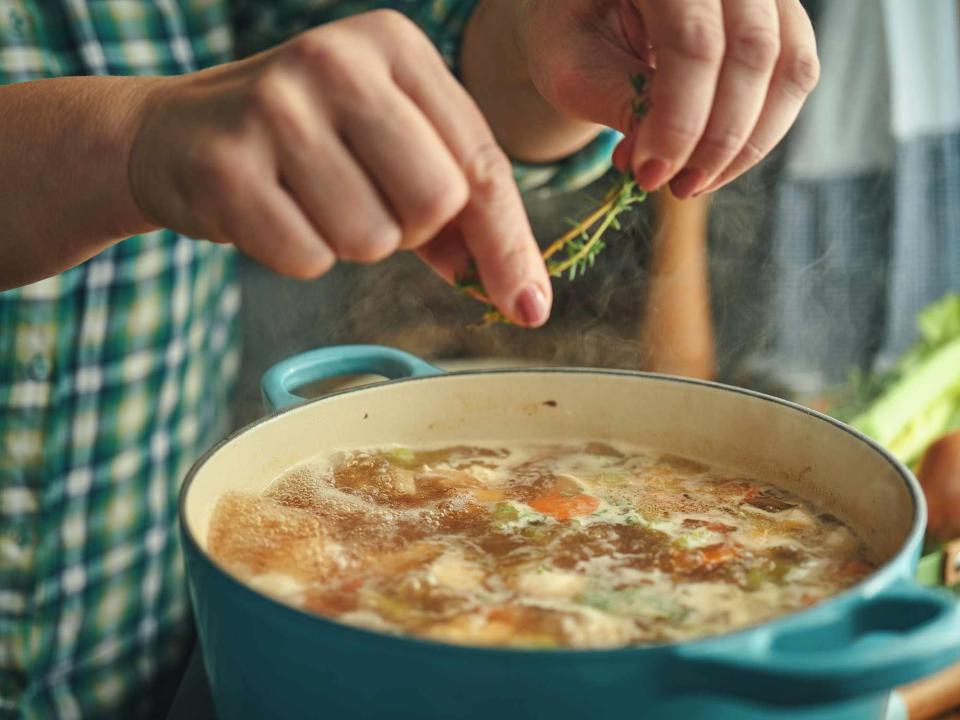What's That Foam on the Surface of My Chicken Broth?
And should I skim it off, or is it fine to eat?

GMVozd/Getty Images
A homemade stock or broth is cozy, comforting, and a great way to utilize a variety of kitchen scraps that would otherwise end up in the trash. It also offers a plethora of assumed (though truthfully debated) health benefits, and like all good things that come to those who wait, making a stock from scratch will always yield tastier results when used in cooking than that from a box or can.
Related:How to Make Store-Bought Chicken Stock Taste Homemade
But if you've ever ventured down the path of filling your home with the aroma from a large stockpot bubbling away on the stove, perhaps in efforts to jump onto the bone broth trend, you've surely noticed a questionable layer floating on top of the liquid accompanying that exceedingly pleasant smell.
What Is This Foamy Layer?
The grayish, greenish, foamy substance is referred to (ever so technically) as "soup scum," or, more politely, "impurities." Whether the term is scientific or not, what's going on within the pot that produces the stuff certainly is.
Bubbling to the surface are rogue proteins that have seeped out of the meat, bones, and higher-protein vegetables and coagulated due to heat. This sudsy scum will be first noticed after the liquid comes to a rolling boil, as temperature is directly related to coagulation; in short, the higher the heat, the faster proteins congeal. Sounds yummy, no?
Can I Consume The Foam?
The short answer to this is yes. The foam on top of chicken broth/stock isn't harmful, it's simply unpleasant. But that unpleasantness is confined to the look (and perhaps the texture) and not the taste, so deciding to rid your stock of this pond-scum-reminiscent substance is purely a matter of preference.
If your goal is a clear, clean-tasting broth or reduced consommé, then removing it will be necessary.
How to Remove Soup Scum
When it comes to removing this pesky "soup scum," skimming is the way to go. Much like you would fish leaves out of a pool, a fine-mesh strainer or spider strainer ran along the surface of the liquid and rim of the pot will do the trick quite nicely — but don't expect it to be a rapid process. A good 10-20 minutes, on average, should be allotted to performing this step. Once the stock is cooled, straining it through muslin or cheesecloth finishes the job nicely. (Though, this final straining step shouldn't be relied upon to do the job entirely on its own).
If you start the process of your stock with cold water that you gradually bring to a boil, the slowly increasing heat will make the coagulated proteins a bit easier to see and skim away.
Related:Our Top 20 Chicken Soup Recipes
Regardless, most if not all, the scum expected to be released usually does so in the first 10 minutes of boiling, so once that's taken care of, you can sit back and relax while the stock does its thing.
A little "trick of the trade" is to stir some beaten egg whites into the broth after it's reached a simmer. The proteins in the egg whites will bond with the other coagulated bits and provide an easily recognizable and skim-able blob, but if there's a bunch of small ingredients in the broth, like vegetables or beans, they could get caught in this solution, so proceed accordingly.
Does the Scum Have to Exist at All?
There are a few ways to avoid having to skim your broth. First, you can pre-boil any meat or bones and rinse them before making stock. This will sacrifice a bit of flavor but will save you the skimming.
Another option is roasting stock bones in the oven prior to making stock, but either of these steps may seem like the same if not more work than simply standing at the stove and skimming.
Finally, you could opt for a pressure cooker. Your home might not sing with the aroma of boiling chicken and vegetables, but the impurities will stick to the bottom of the pot and your broth will come out clear.
To Skim or Not To Skim
Ultimately, taking the time to remove the scum off your soup is your choice. If it doesn't bother you to look at and your broth is being used solely to cook other things, maybe leave it alone and save yourself the trouble. If you're making a soup and you'd prefer to see the other ingredients floating in the bowl without conjuring images of dirty pond water, go ahead and get rid of it.
Either way – happy slurping!